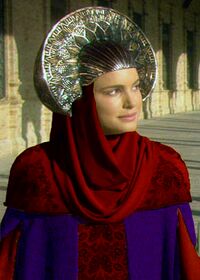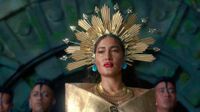Monarchy of Orioni
| Empress of Orioni | |
|---|---|
 | |
| Incumbent | |
 | |
| Joni I of Orioni since 1 March 2003[1] - present | |
| Details | |
| Style | Her Imperial and Royal Highness |
| Heir apparent | Alesia, Grand Princess of Dion |
| First monarch | Anahita |
| Residence | Imperial Palace of O'polis Royal Castle of Ierakshini |
| Appointer | Hereditary |
| Website | www.monarchy.io |
This overview of Monarchs of Orioni presents the traditional order of succession. Records of the reigns of the Empresses and Queens of Orioni are compiled according to the traditional Orinese calendar. In the Hanzei system, which has been in use since the late-fourth century, years are numbered using the Orinese era name and the number of years which have taken place since that era started. The sequence, order and dates of the first 28 Monarchs of Orioni, and especially the first 16, are based on the Orinese lunar calendar system.
Imperial family
As a hereditary constitutional monarchy system, the role and operation of Orioni's monarchy is governed by the Constitution. The imperial office of Empress is designated solely for a female descendant of the first monarch of Orioni, Anahita. The oldest daughter is known as the Heiress Apparent and is educated in the art of politics, responsibilities and intrigue. The oldest son is known as the Champion Prince of the Sword and is expected to command the royal guard and advise his sister in military affairs. If there is no son of a suitable age, a Captain will be appointed as the commander of the royal guard.
Currently, the imperial household consists of the following members:
- HI&RH Joni I, Empress of Orioni (The monarch), Defender of the Four Shores, Queen of Dion, Queen of Meda, Prima of Oris, Guardian of Mount Silesto, Pearl of all People
- HRH Alesia, Grand Princess of Dion (The Empress' cousin), first in line to inherit the throne should The Empress remain daughterless
- Unnamed daughter[2]
- TRH Duchess and Duke of Perseus (The Empress's cousin and cousin-in-law), second in line to inherit the throne
- TRH Duchess and Duke of Andro (The Empress's cousin and cousin-in-law), third in line to inherit the throne
- HRH Toren Nabérrie, Prince of Orioni (The Empress' brother), commander in the Imperial Orinese Navy
- HGDH Graeme Nabérrie, former Prince consort, Archduke of Sirius (The Empress' father)
Ancestors
| Ancestors of Monarchy of Orioni | |||||||||||||||||||||||||||||||||||||||||||||||||||||||||||||||||||||||||||||||||||||||||||||||||||||||||||||||||||||||||||||||||||||||||||||||||||||||||||||||||||||||||||||||||||||||||||||||||||||||||||||||||||||||||||||||||||||||||||||||||||||||||||||||||||||||||||||||||||||||||||||||||||||||||||||||||||||||||||||||||||||||||||||||||||||||||||||||||||||||||||||||||||||||||||||||||||||||||||||||||||||||||||||||||||||||||||||||||||||||||||||||||||||||||||||||||||
|---|---|---|---|---|---|---|---|---|---|---|---|---|---|---|---|---|---|---|---|---|---|---|---|---|---|---|---|---|---|---|---|---|---|---|---|---|---|---|---|---|---|---|---|---|---|---|---|---|---|---|---|---|---|---|---|---|---|---|---|---|---|---|---|---|---|---|---|---|---|---|---|---|---|---|---|---|---|---|---|---|---|---|---|---|---|---|---|---|---|---|---|---|---|---|---|---|---|---|---|---|---|---|---|---|---|---|---|---|---|---|---|---|---|---|---|---|---|---|---|---|---|---|---|---|---|---|---|---|---|---|---|---|---|---|---|---|---|---|---|---|---|---|---|---|---|---|---|---|---|---|---|---|---|---|---|---|---|---|---|---|---|---|---|---|---|---|---|---|---|---|---|---|---|---|---|---|---|---|---|---|---|---|---|---|---|---|---|---|---|---|---|---|---|---|---|---|---|---|---|---|---|---|---|---|---|---|---|---|---|---|---|---|---|---|---|---|---|---|---|---|---|---|---|---|---|---|---|---|---|---|---|---|---|---|---|---|---|---|---|---|---|---|---|---|---|---|---|---|---|---|---|---|---|---|---|---|---|---|---|---|---|---|---|---|---|---|---|---|---|---|---|---|---|---|---|---|---|---|---|---|---|---|---|---|---|---|---|---|---|---|---|---|---|---|---|---|---|---|---|---|---|---|---|---|---|---|---|---|---|---|---|---|---|---|---|---|---|---|---|---|---|---|---|---|---|---|---|---|---|---|---|---|---|---|---|---|---|---|---|---|---|---|---|---|---|---|---|---|---|---|---|---|---|---|---|---|---|---|---|---|---|---|---|---|---|---|---|---|---|---|---|---|---|---|---|---|---|---|---|---|---|---|---|---|---|---|---|---|---|---|---|---|---|---|---|---|---|---|---|---|---|---|---|---|---|---|---|---|---|---|---|---|---|---|---|---|---|---|---|---|---|---|---|---|---|---|---|---|---|---|---|---|---|---|---|---|---|---|---|---|---|---|---|---|---|---|---|---|---|---|---|---|---|---|---|---|---|---|---|---|---|---|---|---|---|---|---|
| |||||||||||||||||||||||||||||||||||||||||||||||||||||||||||||||||||||||||||||||||||||||||||||||||||||||||||||||||||||||||||||||||||||||||||||||||||||||||||||||||||||||||||||||||||||||||||||||||||||||||||||||||||||||||||||||||||||||||||||||||||||||||||||||||||||||||||||||||||||||||||||||||||||||||||||||||||||||||||||||||||||||||||||||||||||||||||||||||||||||||||||||||||||||||||||||||||||||||||||||||||||||||||||||||||||||||||||||||||||||||||||||||||||||||||||||||||
Regnal name
A regnal name, or reign name, is the name used by monarchs during their reigns and used subsequently to refer to them. Since ancient times, monarchs have frequently, but not always, chosen to use a different name from their original name when they accede to the monarchy. The monarchs of Orioni have traditionally used the regnal name "of Orioni", followed by a regnal number (ordinal), usually written as a Roman numeral (V rather than 5), to provide a unique identification for that monarch among other monarchs of that realm.
Crown jewels

The Crown Jewels of Orioni are 15 royal ceremonial objects kept in the Sun Tower of O'polis, which include the regalia and vestments worn by Orinese empresses at their coronations. Objects used to invest and crown the monarch variously denote her role as head of state. These regelia also include the water lily sceptre.[3]
The Marin set includes a diamond tiara and matching necklace, whose design was based on Tamurin roses. The tiara has three floral brooches which can be detached and used separately. The necklace was made consisting of 38 diamonds with a diamond-encrusted snap. A detachable double-drop pendant, made of 13 emerald-cut diamonds and a pear-shaped drop, makes up the pave-set centre of the necklace.
Matrilineality
Matrilineality is the tracing of descent through the female line. It is the societal system of Orioni in which each person is identified with their matriline – their mother's lineage – and which involves the inheritance of property, succession and titles. In a matrilineal descent system, an individual is considered to belong to the same descent group as her or his mother. This matrilineal descent pattern is in contrast to the more common pattern of patrilineal descent from which a family name is usually derived. The matriline of historical nobility was also called her or his enatic or uterine ancestry, corresponding to the patrilineal or "agnatic" ancestry.
Orinese women enjoy high status within their society, compared with their Europan counterparts and with other oriental nations: Orinese social status is transmitted through women, with residence often matrilocal. Most women could read and write, while most men were illiterate, concerning themselves mainly with herding livestock and other male activities. The livestock and other movable property were owned by the women, whereas personal property is owned and inherited regardless of gender. In contrast to most other oriental cultural groups, men wear veils, but women do not.
Succession
This article is incomplete because it is pending further input from participants, or it is a work-in-progress by one author. Please comment on this article's talk page to share your input, comments and questions. Note: To contribute to this article, you may need to seek help from the author(s) of this page. |
Succession is governed by female-preference uterine primogeniture, under which only legitimate female-line descendants inherit, and elder children inherit before younger ones of the same gender, to the total exclusion of males. This system excludes the possibility of an illegitimate child of royalty, or a "Royal bastard", as it is prevalent in other, less civilised nations. After an individual ascends the throne, she reigns until death.
If there is no daughter, an Irregular Succession may take place, where the crown of Orioni passes to the eldest female cousin. Such irregular successions are fraught and tense affairs, but seldom turn violent. Orioni projects an image of unity and strength at odds with many of its neighbours (particularly in Europa) and internal divisions downplayed, to the outside world at least.
When a monarch dies, the following hymn is sung.
Open are the double doors of the horizon
Unlocked are its bolts
Men fall
Their name is not
Seize thou this queen by her arm
Take this queen to the sky
That she not die on Eurth
Among men
Upon the death of a sovereign, her heir immediately and automatically succeeds, and the accession of the new sovereign is publicly proclaimed. Upon their accession, a new sovereign is required by law to make and subscribe to several oaths. The monarch is usually crowned in the throne room of the imperial palace, normally by the most senior member of the imperial household. A coronation is not necessary for a sovereign to reign. The ceremony usually takes place many months after accession to allow sufficient time for its preparation and for a period of mourning. During a coronation, the following hymn is sung.
Open are the double doors of the horizon
Unlocked are its bolts
Clouds darken the sky
The stars rain down
The constellations stagger
The bones of hellhounds tremble
The porters are silent
When they see this queen
Dawning as a soul
List of dynastic periods
For a full overview of each monarch, please see the official list of Monarchs of Orioni.[4] For brevity, we have listed the historical periods of the monarchy in Orioni. This can be compared to dynasties with specific characteristics.
| Order | Period | Duration | Note |
|---|---|---|---|
| 1 | Erwanin period | 980-581 BCE | Queendom established |
| 2 | Nintoku period | 581 BCE-313 CE | First Orioni Empire established |
| 3 | Hanzei period | 313-758 | - |
| 4 | Mikito period | 758-884 | Expansion into Magna Europa |
| 5 | Yasu period | 884-930 | - |
| 6 | Ira period | 930-1087 | Imperial grandeur leads to unrest; black death plagues the empire; failed assassination; imperial law review; civil war |
| 7 | Ino period | 1087-1318 | End of civil war; Second Orioni Empire established; Hierapolis re-founded as Zuidhaven |
| 8 | Taneino period | 1318-1500 | Colonial empire |
| 9 | Oino period | 1500-1663 | - |
| 10 | Owara period | 1663-1709 | - |
| 11 | Ogimachi period | 1709-1771 | Elevation (pseudo-Enlightenment) |
| 12 | Omei period | 1771-1867 | Industrialisation |
| 13 | Nabérrie period | 1867-present | Decolonisation |
Dynastic periods of Orioni.
Pretenders to the throne
In the eleventh century, two lines of the Imperial clan, Western Court and Eastern Court, claimed the throne. Their rivalry led to a brutal Civil War (1023-1174). The Eastern Court, also known as the "Medanese Pretenders" or "Akrep Pretenders", conquered all of southern Orioni, taking the capital in 1063 and installing Empress Osirsep as the 1st of the Pretenders. The Reconquista managed to restore the Orioni line, but this rival claim was never resolved. After the restoration, rival claimants to the throne of the empire of Orioni continue from the Medanese line, from 1056 until today. A prophecy from the 16th Century claims that: "The Crown of Crowns shall be destroyed when blades of light pierce the sky. On that day the twinkling stars will show the way, and the dragon flies once more."[citation needed] The current rival claimant is Carla Estada (°1947), Duchess of Meda. However, the Orinese government has officially declared the eastern claimants as unlawful pretenders.
External links
- www.monarchy.io (official website)
References
- ↑ Roiters, Convictions for Hensei paparazzi, 24 February 2006.
- ↑ HRH Alesia presents daughter to the wurld ()22 Augustus 2022)
- ↑ OOC. A “water lily scepter” [sic] is mentioned in one of the Pyramid Texts of Unas at the end of the Fifth Dynasty.
- ↑ List of Monarchs of Orioni (docs.boogaloo.com)


